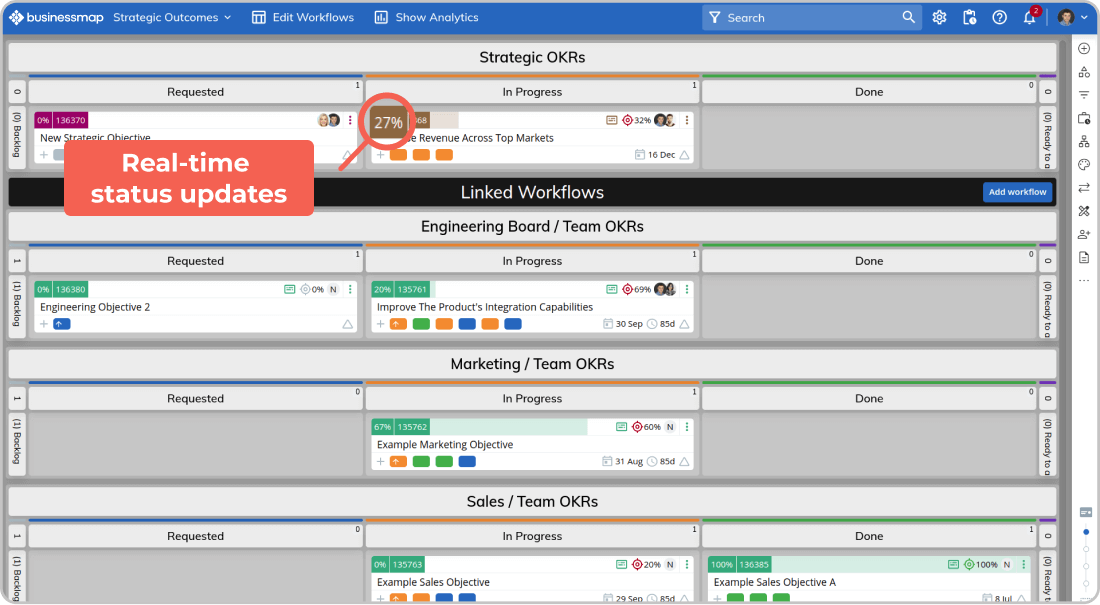What is your stance on the initiative vs. project discussion? A number of opinions exist about how the two terms relate. They may be considered opposing by some, relative by others, or the same by a third. To make things clear, let’s first set solid grounds for the conversation about the role of initiatives and projects in strategic planning.
Initiatives and Projects Definition
Although often used interchangeably, initiatives and projects have distinct meanings in the context of business and organizational management. Let's explain in more detail.
What Is an Initiative in Business?
According to the Cambridge Business English dictionary, the definition of Initiative is “a new plan or action to improve something or solve a problem”. The examples give an even better understanding of what initiatives represent: a marketing/cost-cutting initiative, a diplomatic/peace initiative.
What Is a Project?
On the other hand, the Project Management Institute (PMI) defines projects as “temporary efforts to create value through unique products, services, and processes”. (Source: PMI)
What Are the Differences between Initiatives and Projects in Strategic Planning?
Although both initiatives and projects represent a focused attempt at delivering something and are essential components of strategic planning, they are not to be mistaken for the same thing. On the one hand, initiatives refer to a plan or action which underlines its strategic nature. On the other, projects can be far more precise, indicating their rather operational character.
That is why in Businessmap, we do not go the initiative vs. project way. We combine them.
Why Initiatives and Projects Should Be Linked Together?
Initiatives and projects provide a concrete path to implement strategic plans, measure progress toward strategic goals, and adapt to changing circumstances.
For us, initiatives and projects are strongly linked. We believe there should be no initiative without projects, and we aim not to have too many projects that do not directly contribute to an initiative. We see initiatives as the bridge between the company mission and everyday operations. They represent the path we take to achieve our targets.
How to Use Initiatives and Projects in Strategy Planning?
Projects are the logical descendants of initiatives as they represent the link between work items and strategic planning. This is how we go from mission to individual tasks in three simple steps.
Step 1: Define Your Strategic Direction Using Initiatives
We want to set foot in new markets and simultaneously enlarge our market share in our current market. That is why on a strategic level we have defined two main types of initiatives that make sense for us – disruptive and growth.
Our initiatives sound somewhat broad:
“Increase revenue from different marketing channels” or “Offer an innovative approach to saving resources”.
One more important thing about our approach towards initiatives: we always do results forecasting for future outcomes based on previous results and set measurable goals. This allows us to track projects’ progress with ease and high transparency.
In other words, we combine our initiatives with results that need to be met. This way we have the direction and the destination we want to reach. We are all set to sail!
Step 2: Develop Operational Projects to Reach Your Strategic Goals
The next question is how we are going to reach this destination. For the “how” part, projects come into the game.
Defining ways to get where we want to be, we start to develop projects that would contribute to achieving our goals.
Step 3: Break Down Projects into Actionable Work Items.
What we particularly value in the combination of initiatives and projects is the ability to decompose the company’s mission into actionable items and everyday tasks. Doing this, we inevitably witness an overall increase in motivation as each of us knows why we are doing what we are doing and how this is contributing to higher goals.
By visualizing initiatives and projects, as well as linking them together on a single visual management board, we manage to establish high-level transparency and alignment on a company level.
Strategic Initiatives as a Component of the Organization's Vision
By now, it is clear that when we say initiatives, we mean strategic initiatives. Going back to the theory, strategic initiatives are the primary method by which a strategy is executed in goals management frameworks such as Balanced Scorecards or OKR.
This is why when defining initiatives in your organization, it’s important to use them as an integrated component to achieve your company goal. It all has to sound logical and interlinked.
A common misconception is to look at strategic initiatives as single silo projects. The reality is that most strategic initiatives require cross-functional teams' execution on the project level.
Another thing strategic initiatives are mistaken for is research and analysis. It is important to integrate data into your strategy, but data alone does not represent strategy execution. You can have a project dedicated to better understanding the market or your customers, but this project will be a part of an initiative, and it is not an initiative itself.
If your strategic initiatives do not meet these requirements, then you probably got them wrong. Successful strategy execution implies strategic initiatives reflect the company's vision of success.
Initiatives vs. Projects Execution
Another difference between the projects and initiatives comes down to the way they are both executed in strategic management.
How to Execute Initiatives?
As strategic initiatives are more complex and usually consist of multiple projects, their execution resembles more the principles of portfolio management than those of project management.
While in project management, we speak about direct outputs and deliverables of a single product, in portfolio management and in managing strategic initiatives, the focus is on outcomes and benefits of the wider company goal in place.
One common challenge in the execution is reporting on strategic initiatives. Having to include more than one project in the report involves doing an aggregated project performance. For this, you first need project reporting with aggregated task performance. A lot of times, such reporting tends to be a real time-eater.
In Businessmap, we put our strategic initiatives on the Portfolio Kanban board. The status of each initiative gets automatically updated based on the status of all tasks from the projects linked to the initiative.
This is our way of keeping our eyes on the prize. Regardless of how you choose to do your reporting, do not underestimate the need for exact numbers. Although we earlier said the focus in strategic initiatives management is more on outcomes than on deliverables, being able to track and analyze their status is crucial for being able to bring initiatives to success.
How to Execute Projects?
Once a strategic initiative is in place, we see how a particular department can contribute to that and create a project. For planning, we use a Kanban timeline where we put these projects and start breaking them down into actionable work items.
Furthermore, to improve work organization, we create multiple workflows on our boards where work activities of different natures can flow through.
As our Kanban boards allow us to visualize the flow of all the individual work items, we can directly see their real-time status and their correlation with the project. Then, on a bigger scale, we are able to align that with the execution of bigger company goals as well. This is also how we align our strategic goals by combining our OKRs with the Agile mindset.
What Are the Benefits of Using Initiatives and Projects?
As discussed, projects and initiatives define the actions companies take to achieve goals. Here are some of the reasons why both play a crucial role in strategic planning:
- Alignment: Projects and initiatives help to align an organization's resources with its strategic goals. By focusing resources on specific projects and initiatives, organizations can ensure that they are working towards their long-term objectives.
- Implementation: Strategic plans are often abstract and high-level. Projects and initiatives provide a concrete way to implement the strategic plan and make progress toward achieving the organization's goals.
- Measurement: Projects and initiatives provide a way to measure progress toward strategic goals. By tracking the success of individual projects and initiatives, organizations can assess whether they are making progress toward their strategic objectives.
- Flexibility: Projects and initiatives provide a way for organizations to be flexible and adapt to changing circumstances. As the environment changes, organizations can adjust their projects and initiatives to ensure that they remain strategically aligned with their goals.
Initiatives vs. Projects or Initiatives and Project
Initiatives play an important role and represent the bridge between the strategic and operational levels. When defining initiatives in your company, be aware not to have an initiative as an end in itself. Each strategic initiative should be a building block towards achieving the company goals and should be decomposed into projects, representing how exactly this goal will be met.
Through our simple three-step planning “mission-initiatives-projects”, we have achieved a higher level of transparency where each of us knows how his or her tasks are linked to the overall company goals. Naturally, this has led to better alignment on all levels and departments. So, for us, initiative vs. project really is initiatives and projects!
Initiatives vs. Projects Frequently Asked Questions (FAQs)
What Is the Difference between Initiatives and Projects?
Initiatives are broader and long-term efforts aimed at achieving a specific company goal or vision, whereas projects are specific, short-term endeavors with defined objectives and deliverables that contribute to achieving an initiative's goals. Initiatives often involve multiple projects and ongoing work, while projects are more concrete.
Can a Project Be an Initiative?
Yes, a project can be part of an initiative or contribute to achieving the goals of an initiative. In this case, the project is a specific effort or activity within the broader initiative aimed at delivering a particular outcome or set of outcomes.
What Is the Difference between an Initiative and a Program?
Initiatives are usually larger in scope and may encompass several programs, while programs are more focused and specific and may involve multiple initiatives or projects. Programs typically have a dedicated budget and resources, while initiatives may be funded through various sources and may involve collaboration across multiple stakeholders.

Nikolay Tsonev
Product Marketing | PMI Agile | SAFe Agilist certified
Nick is passionate about product marketing and business development and is a subject matter expert at Businessmap. With expertise in OKRs, strategy execution, Agile, and Kanban, he continues to drive his interest in continuous improvement. Nick is a PMI Agile and SAFe Agilist certified practitioner.








